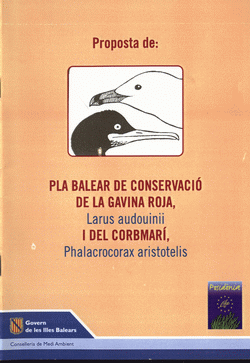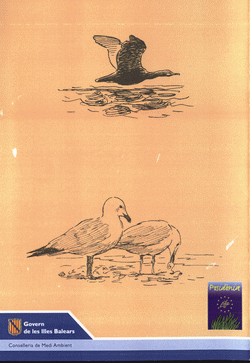Aims:
Wording of the Conservation Plan for both species, taking into account
the state of the populations in the Balearics as studied, threatening
factors identified, and proposals made for actions that would most adequately
preserve the species. This Plan collected the aims and actions proposed
in the Community Action Plans for both the Audouin Seagull and the Common
Shag Cormorant.
Development:
The action was carried out by hiring ( by means of a Service Contract)
the services of a company reputed for its expertise in compiling documents
of this nature (“Consultores en Biología de la Conservación,
SL”-- Consultants in Conservation Biology, Ltd.), and with the support
of experts from the “Servicio de Conservación de Especies”
(Service for the Conservation of Species). The studies and conclusions
thereof, produced by this company with the collaboration of the experts,
were then sent to the people in charge of wording the Plan.
The first edition of the Plan went to the environmental operators of the
“Plan Balear de Conservación de la Gaviota de Audouin (Larus
audouinii) y del Cormorán moñudo (Phalacrocorax aristotelis)”
—the Balearic Plan for the Conservation of Laurus audouinii Seagulls
and Phalacrocorax aristotelis Cormorants.
Once the wording had concluded, the Plan was approved by the “Consejo
Asesor de Fauna y Flora” --- the Advisory Council for Flora and
Fauna--, in the session held on the 3rd of May ,2006, and was duly published
in the Official Governmental Bulletin of the Balearic Islands (BOIB).
The original aim of the project has been fulfilled, as this was none other
than the wording of the conservation plan for both species.
The Red Seagull, Laurus audouinii and the Cormorant, Phalacrocorax aistotelis,
are sea birds and their population is widely distributed throughout Balearic
coastline. Both species suffer similar problems in terms of conservation.
Both species are included in the National Catalogue of Endangered Species,
in the category of Special Interest, and this status means that a conservation
plan must be drawn up. These birds are also included in the annex I of
the CEE/79/409/ Directive , known as the Directive on Birds, which indicates
that these species are to be included in special protection measures in
terms of their habitat, in order to ensure their survival and reproduction
in areas they populate.
The Red Seagull and the Common Shag Cormorant live in the same habitat,
and are to a great extent subject to the same or similar limiting factors.
Therefore a common action plan has been drawn up and worded since specific
actions included in the plan coincide, in part, for both species. The
Plan includes a synopsis of the biology of each species, an analysis of
the known and potential conservation problems, the general and specific
aims of the Plan and the common and specific actions.


More information son to be available at: http://dgcapeea.caib.es/pe/especies.es.htm